The black birds in my backyard are always entertaining. They always seem to be doing something new or surprising. Recently, I noticed that a few of the black birds had red eyes. At first, I thought it was just an odd coincidence, but after looking more closely, I realized that this is actually a common trait among some black birds.
I did some more research and came up with this comprehensive list of black birds with red eyes. These red eyed birds range from the spotted towhees to the common bronzed cowbird. Below we’ll explore common and uncommon birds. So let’s get started
List of Black Birds with Red Eyes
1. American Coot
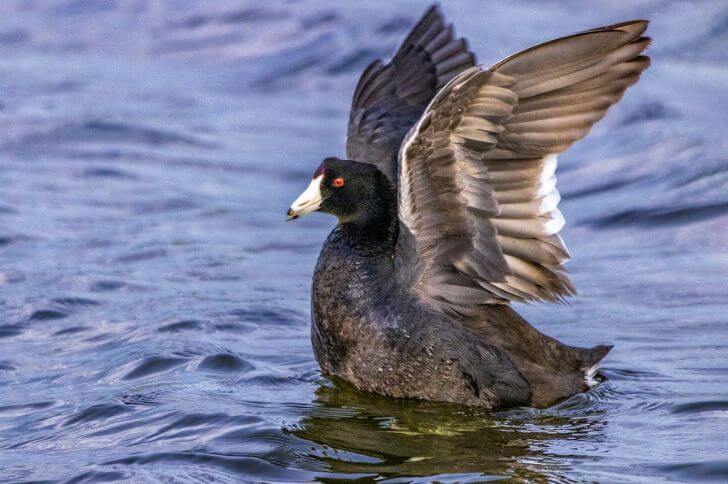
Also known as the mud hen, the American Coot is a common water bird that can be found all over North America. These birds are easily recognizable by their large body that measures about 14 – 17 inches, their black-grayish feathers, and their characteristic large white bill. Note their stunning red eyes.
American Coots are excellent swimmers, and are often seen swimming or wading in ponds, marshes, and other bodies of water. They are also known for their vocalizations, which include a variety of “poonk” and “puhlk” sounds.
American Coots feed on a variety of items, including aquatic plants, small fish, and insects. These red eyed birds mate from May to June. During breeding season, these diving ducks lay up to 9 eggs which take about 21 days to hatch.
2. Junin Grebe
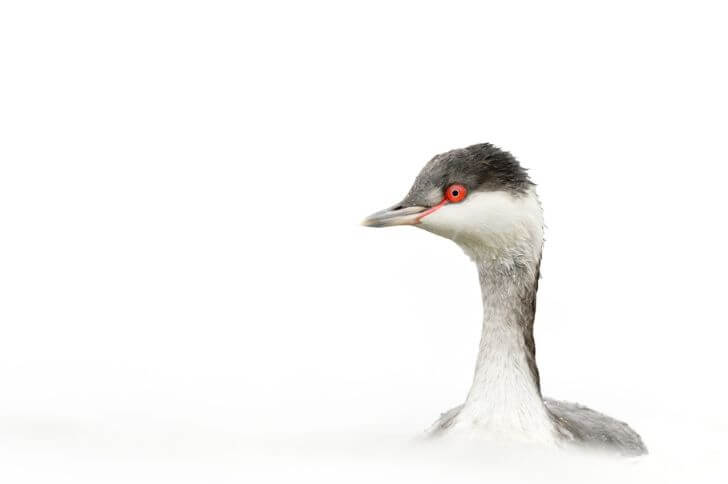
How large are the spotted towhee? They are similar in size to the robin. Adult males can measure up to 8 inches in length and weigh about 1.7 oz with a wingspan of 11 inches.
Looking for a red eyed grebe? The junin Grebe is a bird that is part of the podicipedidae family which includes other red eyed grebe birds. Junin grebes are easy to identify with their dark crown and back, long thin white neck, and the most notable feature, the red eyes.
Like the American coot, this large black bird with red eye is a good swimmer and can often be seen diving for fish in lakes and rivers.
Great Crested Grebes make good parents, and take care of their young until they are able to fly and fend for themselves. When not swimming or diving for food, these birds can often be seen perched on logs or other objects near the water’s edge. They are endemic to Peru, and are considered to be endangered.
These birds are known for their loud “doo’ith” whistles which are often heard during their breeding season.
3. Spotted Towhee
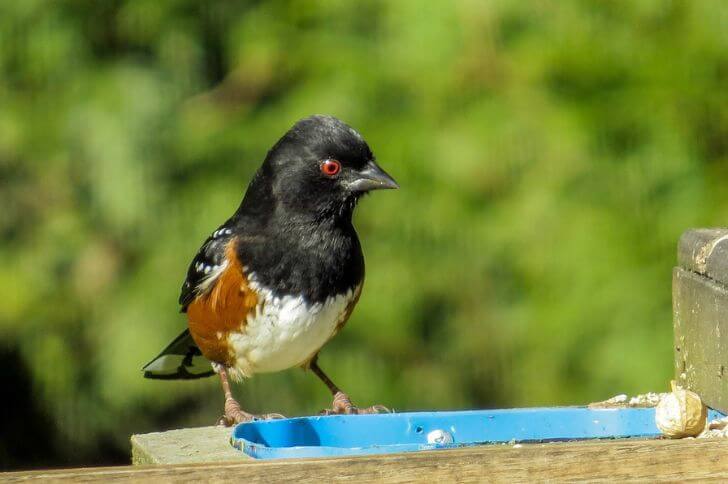
Large, long-tailed, and easy-to-spot, the spotted towhees belong to the family passalidae. They favor open woodlands and scrub in the western half of North America.
This stout bird has a black head and back, with white spotting on the back, and rufous sides and white belly. Juveniles are duller without the rufous plumage. Both sexes have beautiful red eyes.
What do spotted towhees eat? They eat insects such as spiders and berries.
4. Phainopepla
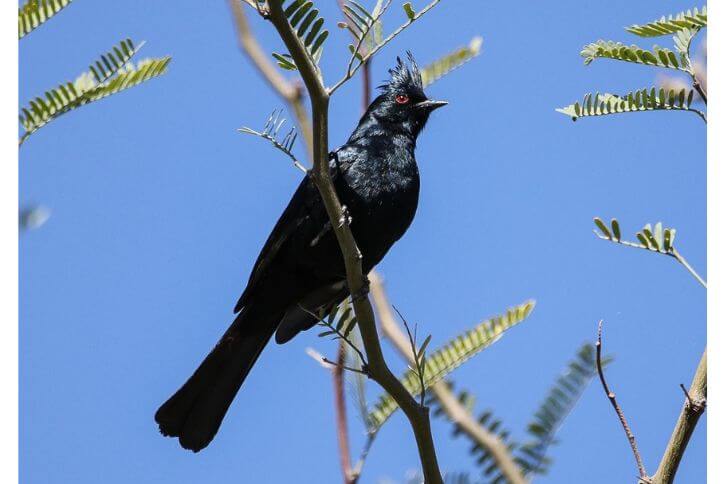
Source:tyounkin72
Ever heard of the phainopepla bird? Also known as the Northern phainopepla, this is a unique bird that favors the deserts of the southwestern United States. You can easily spot them in Southern California, Nevada or the desert oases of Arizona.
What does a phainopepla look like? This bird is known for its distinctive black plumage with black patches on the wings which you can only spot when this red-eyed bird is in flight. Note the unique crest on both sexes’ heads.
Is a phainopepla cardinal? No, phainopepla birds belong to the ptiliogonatidae family which includes silky flycatchers. Cardinals belong to the cardinalidae family.
They are solitary birds that feed on insects and fruit.
5. Western Grebe

Another large water bird with red eyes from the grebe family is the Western Grebe. Preferring salt marshes and freshwater spots, this large black and white bird with red eyes can be seen in parts of Western North America. They are somewhat stocky in build and have a long, pointed bill.
They are dark brown – black on the upperparts and white on the underparts, with a black cap and eye spot. They breed in wetlands making a floating nest of grasses and other vegetation. The Western Grebe is a versatile feeder, consuming aquatic insects, fish, amphibians, and small mammals.
Can a western grebe fly? With a wingspan of up to 40 inches, western grebes seldom fly even when migrating.
Can western grebes walk on land? Unlike other waterbirds, they are rarely seen on land. Their feet are awkwardly positioned at the back of their large bodies, making it difficult for them to walk around.
6. Greater coucal
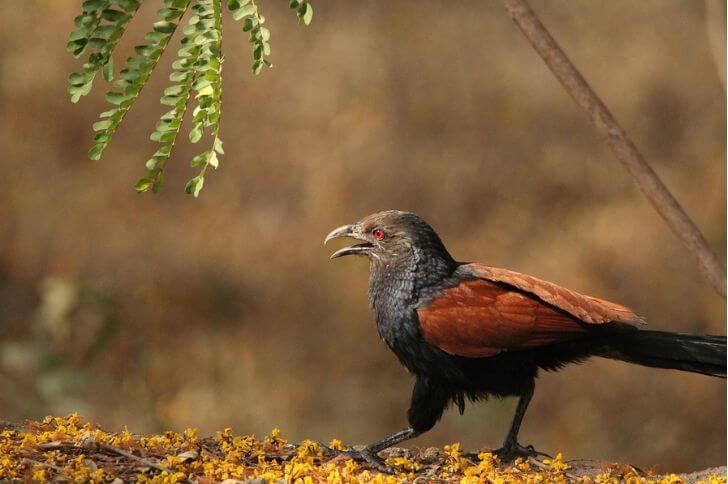
If the pheasant and crow ever had a kid, it would look like the greater coucal. Found in part of Asia, this bird is a great sight to watch.
This red-eyed coucal is a large, dark colored bird that is related to crows and ravens. They are typically found in wooded areas, near water, or in open fields. They are most active during the day and feed on insects, small mammals, and fruits.
The greater coucal is a very large bird, typically measuring 18 inches in length. They have a long tail and a thick neck. They are mostly black with some brown feathers on their wings. Notice the strong black bill that comes in handy when foraging for food.
What does the greater coucal eat? Their meals consist mainly of snails and different types of insects. They also eat seeds and other birds’ eggs.
What sounds does the greater coucal make? The greater coucal bird is known for its hissing threat sounds and rapid “lotok” and booming “cooop-cooop” sounds.
7. Bronzed cowbird

Source: javier_elultimochihuihui
Often seen in large flocks, the bronzed cowbirds are a blackbird with a metallic bronze sheen on their feathers. They are about 7.9 inches long with a stout beak and long tail. Male bronzed cowbirds are black with striking red eyes while females are duller with a brownish belly.
Bronzed cowbirds are common in open woodlands, grasslands, and agricultural areas. They eat insects, seeds, and fruit.
Bronzed cowbirds are brood parasites; they lay their eggs in the nests of other birds. The host birds incubate the eggs and raise the young cowbirds as their own. Bronzed cowbirds are very successful at this; over 60% of their eggs hatch into chicks that survive to fledge.
Bronzed cowbirds are year-round residents in much of their range. They are not considered to be threatened or endangered, but they are declining in some areas due to habitat loss.
What makes bronzed cowbirds unique? The male is known for its unique puff out display that they use to win over females.
8. Common Loon

The common loon, or Gavia immer, is a large aquatic bird that is found in North America and parts of Europe. It is one of the largest members of the loon family and is easily recognized by its black and white plumage, red eyes, and distinctive yodel-like call.
The common loon can be found in a variety of habitats, including lakes, ponds, marshes, and rivers. It feeds on a variety of prey items, including fish, amphibians, insects, and crustaceans.
Despite its wide distribution, the common loon is considered to be a vulnerable species due to factors such as habitat loss and degradation. In addition, many people view the loon as a pest due to its habit of preying on fish in popular recreational waters.
Are loons aggressive? Adult loons are known to fight each other which can at times lead to serious injuries.
Do common loons mate for life? No, this bird species is known to switch partners and territories.
9. Red-eyed puffback
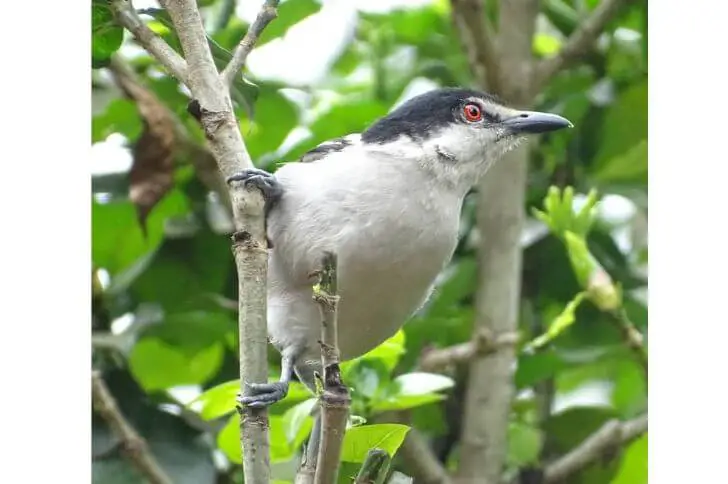
Source: jry_mmasi
Preferring moist lowland forests of Central Africa, the red-eyed puffback is a medium-sized bird that is mostly black with a white throat, breast, and belly.The eyes are bright red.
These small black birds with red eyes are in the bushshrike family whose main diet consists of large insects. This vocal bird is known for its “kyew-kyew” calls.
10. Spangled drongo
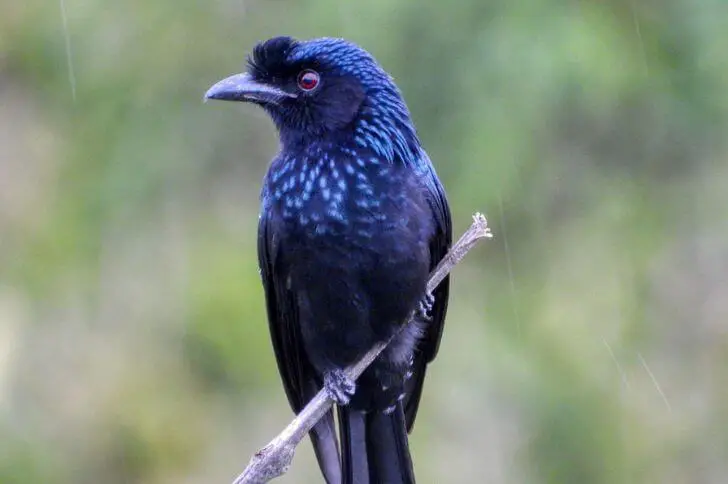
Spangled drongos are medium-sized passerine birds found in open forests, woodlands and gardens in parts of Australia. You can easily spot this red eyed bird in Queensland and Brisbane.
It features glossy black plumage with red eyes, tapered tail and a black bill. The sexes are similar. This species has a loud “sneeze” call which is often given in flight. It feeds on insects which it catches in mid-air or gleans from tree branches.
The spangled drongo is a territorial bird which defends its territory against other birds of the same species.
Is the spangled drongo native to Australia? Spangled drongos can be found in urban areas such as Brisbane and Queensland.
11. White-winged chough
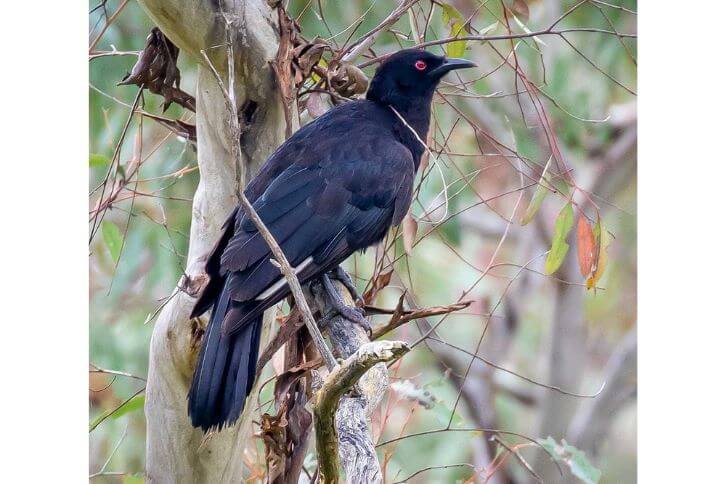
Source: julesv8s
Another bird with red eyes that is a resident breeder in Australia is the white-winged chough. Found in Eastern and Southern Australia, this medium-sized bird is in the crow family, Corvidae.
Sexes are similar in appearance; Black feathers, black bill and feet, and bright red eyes.
How big is the white-winged chough? This bird is about 18 inches in length. Why do choughs have red eyes? Like other red-eye birds, white-winged choughs have less melanin in their iris which makes blood vessels more visible, giving them the bright red appearance.
What do chough birds eat? They prefer beetles and termite.
12. Asian Koel
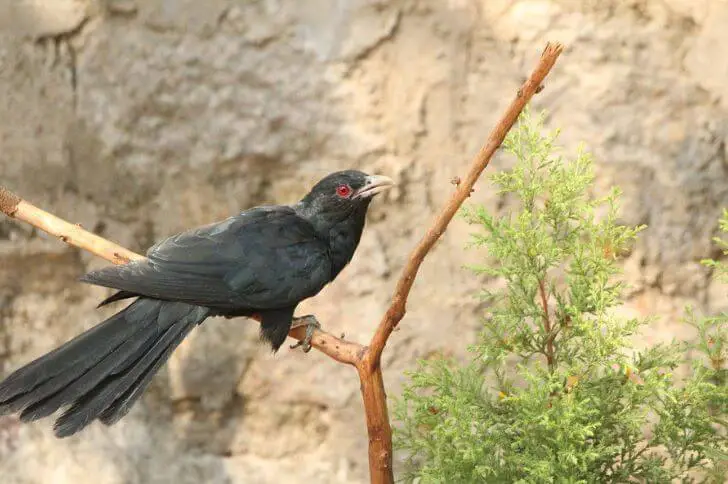
Is Asian Koel extinct? There are over 100,000 pairs in parts of tropical Asia. This black bird with red eyes is a member of the cuckoo family which includes other birds like yellowbills and road runners.
It is a resident breeder in much of tropical Asia, but also ranges into the Himalayas. They are found in open woodland and cultivation. The Asian Koel is a large, long-tailed bird; black overall with a white bill and red eyes. Females spot a different look.
Female Asian Koels are brownish-black and heavily striped. Both sexes measure 18 inches in length and weigh around 11 oz.
These blackbirds are omnivorous, eating insects, fruit and seeds. Like other koels they are a brood parasite. They usually lay two eggs in a clutch in another bird’s nest. The eggs hatch after about 2 weeks.
13. African Oystercatcher
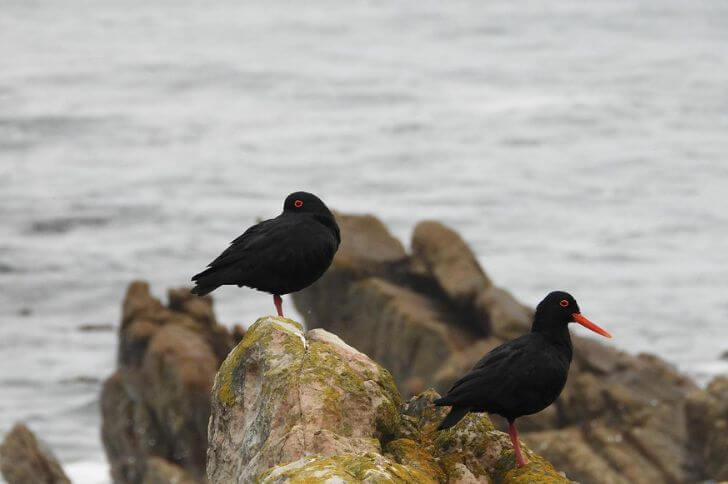
Red feet, red eyes, and a red-orange bill, the African oystercatcher is an unmistakable bird. Found in the coastlines of Africa, this large shorebird is easily identified by their black, long bill, and orange eye-ring.
The long reddish bill is used to feed on oysters and other shellfish. African oystercatchers are monogamous birds, and they typically mate for life. Both parents care for the chicks, which are able to fly within a few weeks of hatching.
Is the African oystercatcher endangered? They have been listed as least concern, meaning the population is steady and increasing.
They nest in rock ledges where the oystercatcher lays 2 eggs. These red eyed birds can live up to 25 years in the wild.
14. African River Martin

Source: andybrumphotos
Closely related to the tree swallow and the purple martin, the African river martin is a small passerine bird that is found in Africa. These birds are a member of the Hirundinae family and their scientific name is Pseudochelidon eurystomina.
Measuring about 5 inches, it is a small bird that has dark blue-black upperparts and underparts with brownish wings. Note the broad orange bill
. The African river martin breeds along rivers and other bodies of water . It builds a cup-shaped nest of sticks in a tree or on a cliff face. The African river martin feeds on insects which it catches while flying or hovering over the water’s surface.
15. Asian fairy-bluebird

Source: wei_luv_nature
With blood red eyes, black body and azure blue back, the Asian fairy-bluebird is a medium size passerine bird found in the forests of Southeast Asia. At around 9 inches long, it is one of the smallest members of the bluebird family.
The male is striking in its deep azure blue plumage on the back while the wings and underparts are black. Female Asian fairy-bluebirds are mainly blue with red eyes.
Asian fairy-bluebirds are territorial and monogamous, forming pairs that defend their territory against other birds all year round. They are shy and retiring birds, preferring to stay hidden in the dense foliage of the forest canopy. They are insectivores, eating mainly insects and spiders.
16. Asian glossy starling
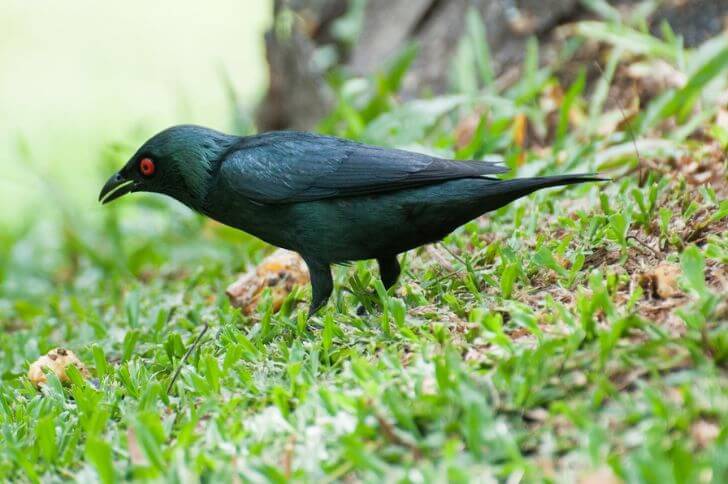
The Asian glossy starling is a passerine bird in the starling family. It is endemic to the Philippines, where it is found on most of the larger islands. It has a black body with a metallic green gloss, black bill and bright red eyes. The sexes are similar, but juveniles are more greenish.
This species is usually seen in small flocks or pairs, foraging for insects on the ground or in trees. It builds a large stick nest in a tree cavity or vine tangles.
The Asian glossy starling was formerly considered conspecific with the African glossy starling but they are now treated as separate species based on differences in vocalizations and genetic data.
17. Dusky tit
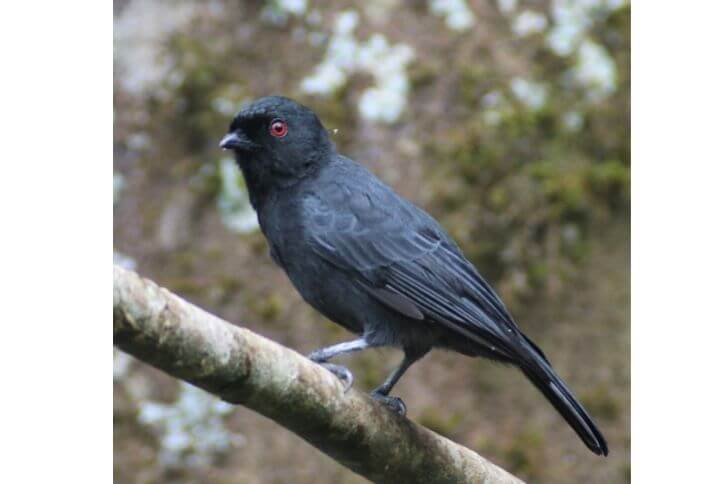
Source: 10_000birds
Dusky tits are small red eyed birds that can be found in open woodlands and gardens throughout Africa. It’s a member of the paridae family. The dusky tit is 5 inches long and weighs about 0.4 oz.
It has black upperparts and underparts. The bill is black, the legs are greyish brown, and the eyes are bloody red. The sexes are similar in appearance, but juveniles are duller than adults.
The dusky tit feeds on spiders and other small invertebrates. It typically forages in trees and bushes, gleaning insects from the leaves and branches. It also hunts for prey on the ground. The song of the dusky tit is a series of high-pitched notes repeated several times.
18. Rockjumper
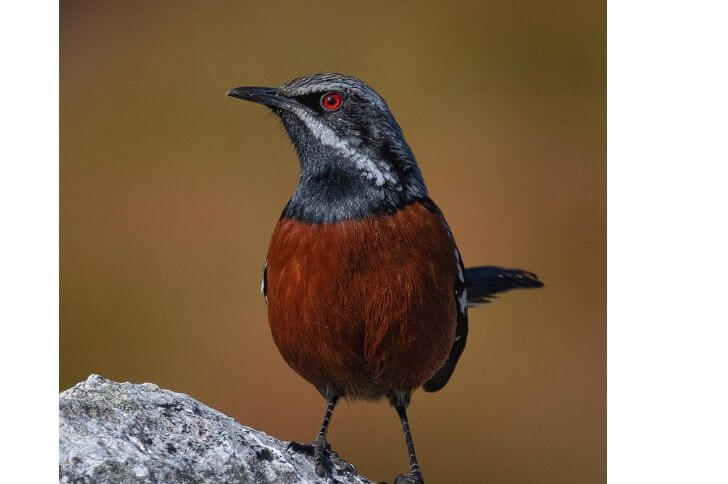
Source: chanan.weiss
Drakensberg rockjumpers are a small, sprightly bird found only in the Drakensberg Mountains of South Africa. It is named for its habit of jumping from rock to rock while foraging for food. The Drakensberg rockjumper is black and white below, with a rufous rump. It is about 9 inches long and weighs about 3.5 oz.
The Drakensberg rockjumper nests in crevices among the rocks, and feeds on insects and spiders. It is shy and difficult to see, but can be spotted by its distinctive call; a series of “tseeur-rip” sounds.
Sources:
https://www.nps.gov/articles/american-coot.htm
https://en.wikipedia.org/wiki/Western_grebe
Hi, my name is Steve. My friend and I started the spanishbirdguides.com to share our passion with other like-minded people. So, if bird watching is your thing, you’ll love this blog. I’ll share what I’ve learnt about both local birds and those found in other parts of the world. Also, I’d love to hear your experiences.



